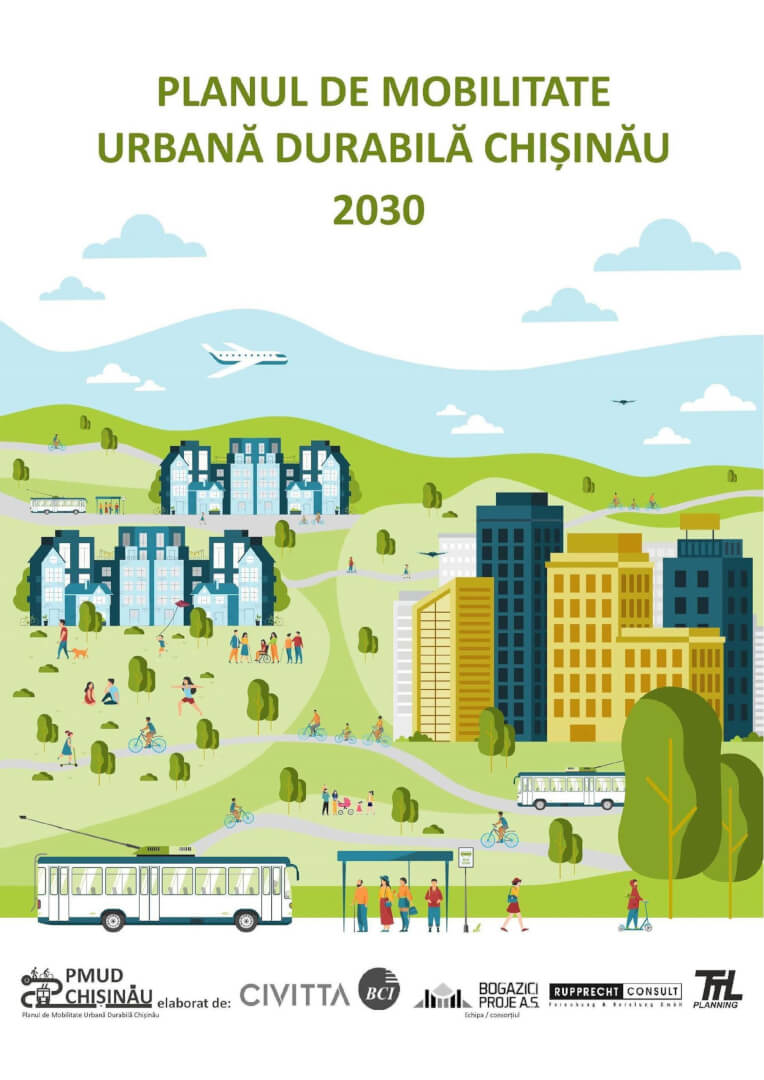Chisinau Sustainable Urban Mobility Plan
About the Chisinau sustainable urban mobility plan
The Chișinău City Hall is currently making efforts to prepare the Sustainable Urban Mobility Plan (SUMP), which sets clear action directions for the city's development until 2030. The City Hall aims to involve the community and the business sector in this process to better understand their mobility needs.
The Sustainable Urban Mobility Plan (SUMP) is a strategic plan designed to meet the mobility needs of people and businesses in cities and their surroundings, for a better quality of life. In addition, it specifies concrete measures for meeting these goals in various fields of action (e.g. cycling, public transport, parking, traffic safety, etc.). The special feature of SUMP Chisinau is the holistic consideration of all modes of transport (pedestrian and bicycle traffic, public transport, car traffic, railway) and all other topics relevant to mobility (traffic safety, urban development, climate protection, air pollution) - also including environmentally friendly drivers, new forms of mobility and the opportunities of digitalization. As an interactive planning tool, it also takes into account the principles of integration, participation and evaluation throughout the entire process.
The main objectives of the SUMP are:
• improving the efficiency of transport services and infrastructure,
• reducing the need to use motorized means of transport, reducing the impact on the environment and reducing energy consumption for transport activities,
• ensuring an optimal level of accessibility within the locality and within the peri-urban area
• ensuring a safe environment for the population,
• ensuring the accessibility of all categories of people (including people with disabilities) to transport services and infrastructure.
The SUMP Chisinau is an integrated part of “MOVE IT like Lublin — a Chisinau public transport sustainable development initiative” of Chisinau Municipality. The project spans over 2 years time (July 2022 – July 2024) and consists of the following parts: an analytical part and a proposal part. The analytical part describes the current status quo of each of the respective modes of transport and of the mobility system as a whole, defines the weaknesses and strengths and provides a basis for the formulation of a vision of the Mobility Plan, the implementation of which is further detailed in the proposal part. Based on a mobility vision, a set of policies, areas of change, measures and projects will be proposed. Moreover, within the project portfolio of activities knowledge exchange activities with European cities and organisations as well as public events in the framework of the European Mobility Week are planned.
Problems and solutions for our city
The transport system of Chișinău
Chișinău is considered the country’s economic, cultural, political, and academic centre and a high share of the national economy is concentrated here. Over half of the total number of the country’s registered enterprises and of industrial production is located in the Chisinau Municipality. Almost half of the total number of the country's employee work in the municipality. The city thus attracts weekly commuters from all over the country, who commute there during the week and return home for the weekend. In addition, there is a large number of daily commuters to work in the city. Commuters usually travel by car due to long distances and poor public transport or railway connectivity. The number of owned private cars constantly increases as part of a trend that will continue during the next years at a 5-10% yearly rate. The public transport service in Chisinau is constantly improving and there is a positive trend in public transport usage. Cleaner and more efficient trolleybuses and buses, an improved ticketing system, better coverage at the metropolitan level and a more reliable schedule make public transport a more attractive mobility option within the city.
As a growing city, Chisinau is characterized by traffic congestion, increasing commute times, scarcity of parking spaces, limited public transportation, incomplete infrastructure for bicycle traffic, and increased environmental pollution and energy consumption.

High levels of traffic noise
Studies show that people are very much exposed and disturbed by noise poluttion is urban areas of Europe. A car speed limit of 50 km/h in cities proved not to be sufficient in terms of motor noise people hear. The human ear perceives traffic noise double so loud at a traffic speed of 50 km/h than at 30 km/ h. Based on this fact, European cities are more and more looking into policies to significantly reduce car speed at 30 km/h in cities, which decrseases the noise levels significantly and at the same time increases the road safety levels.
Low air quality
Too high levels of emissions (for example nitrogen dioxides NO2) in the air, which our fuel-engine cars release every time we go for a drive, cause significant risks for our health and for the environment. The transportation sector is responsible for almost 30% of the share of European Union’s total GHG emission (2019), with a 20% being assigned to road transport. The EU is now making significant efforts to reach ambitious environemtnal targets together with all governments and cities. The transprt sector only is engaged in reducing its emissions by at least 55% by 2030 and 90% by 2050 (according to The New Urban Mobility Framework, 2021).
Too many road accidents
Reducing car speed in the city has yet another advantage: road safety levels are increasing. More and more cities in Europe started to plan for Vision 0 (zero road fatalities / year) as traffic safety has become a major concern in the last decade. Within SUMP Chisinau, the team of experts will analyse the main hotspots of traffic incidents, causes of incidents, their evolution and identify areas that need urgent traffic safety and traffic calming measures.
